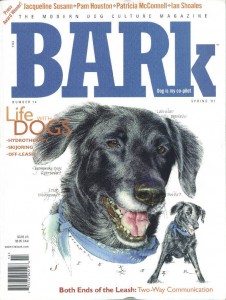Bark
In 1996, Becky Lloyd, a dog-lover who rescues Labrador Retrievers, was called out by a friend from her kennel club to look at a young Lab who was hanging around an Iowa farmhouse. When she arrived, Lloyd could see that the dog was severely injured – a broken front leg and dislocated shoulder. He could barely walk. His nose was swollen to the size of a tennis ball from two puncture wounds. A greenish discharge oozed from his nostrils. Lloyd figured he’d been hit by a car, then perhaps bitten by another animal. She estimated he was only six to eight months old.
Lloyd knew that she couldn’t take the dog home; she couldn’t risk exposing her own dogs to whatever was causing the nasal discharge. But she also knew that a dog with such injuries had little chance of survival, much less finding a new home. The local humane society said it could make him comfortable for the night, but that his injuries were probably too expensive to fix. A veterinarian said she could euthanize him right away – as long as it was paid for. The sheriff offered to shoot him. The kindest, most logical choice would be to humanely end his life, Lloyd knew, as she cautiously approached the scrawny dog lying in the yard.
“I was ready to get bitten,” recalls Lloyd. “But I knelt down near him and you know what he did? He wagged his tail. He wagged his tail. He showed me the qualities that every true Lab has – compassion, spirit, forgiveness.”
Lloyd was certain she couldn’t let this dog be put down, not now. But wags or not, she still had no good options. She decided to send him to the humane society while she figured out what to do. “I just couldn’t take him,” she says. “It killed me.”
Late that night, Lloyd poured out her heart to some new friends on the Internet, the members of a Labrador discussion group called Labrador-L. In an e-mail entitled “Sad Little Man,” she wrote of her anguish over the sweet young dog: “It would have been easier to destroy him, but the wag of the tail, in the midst of his great pain and suffering, would not allow me to take the easy way out.”
In the morning, Lloyd called the humane society. The dog was not in good shape, she was told. His leg would have to be amputated. And his nose injuries had been caused not by animal bites, but by buckshot. Someone had used the dog for target practice. It would cost at least $400 to save him, the staff said. Lloyd despaired at the thought of raising enough money. Then she sat down to read her e-mail.
Overnight, news of the “sad little man” had made its way around the world. And by morning, more than 100 people had written to Lloyd, offering encouragement and financial help. The very first pledge, from a Virginia man she’d never met, promised $100.
Lloyd was stunned by the response to her midnight message. “I was flooded with e-mails,” she says. “Every time I received a message from someone, I would start to cry.” Within days, she had heard from more than 700 people and had more than enough money to care for the little Labrador. Bullet, as he was christened, got his surgery and Lloyd soon took him home with her to recuperate and adjust to life on three legs.
But the story doesn’t end there. Within days, two members of the Labrador-L list cooked up the idea of using Bullet’s leftover funds to help other needy Labradors. They quickly set up an Internet-based non-profit organization, LABMED, and started raising more money. Today, after just three years of operation, LABMED has raised more than $139,000 for the medical expenses of rescued Labradors. More than 200 dogs have been helped—all are loving animals who were deemed adoptable, but who would likely have been euthanized due to medical needs that were too expensive for local rescue groups to handle. Among them are Tucker, a 14-week-old chocolate male whose abusers left him with two broken legs; Heidi, a yellow female who was dumped by the side of the road with mouth injuries that probably resulted from a kick; and Lucy, a black female who was found as a stray and needed hip surgery. All have had their problems treated and all have been placed in loving “forever” homes. “We believe in Second Chances,” declares the LABMED website.
But mostly, he’s Dranda’s devoted companion. “He loves to be with me, and I love to be with him,” she beams.
